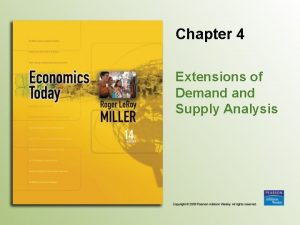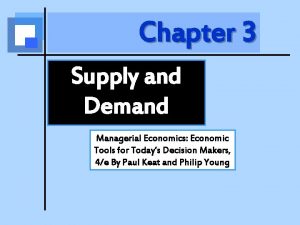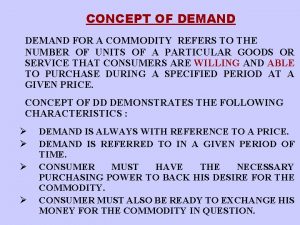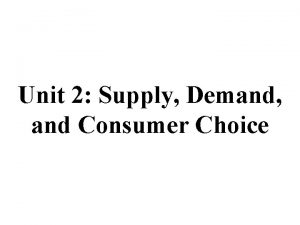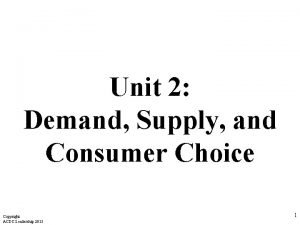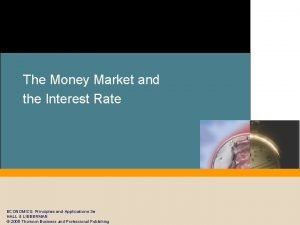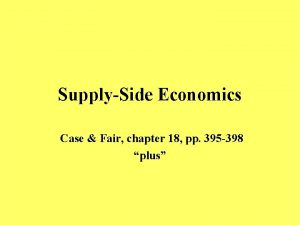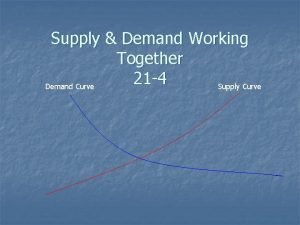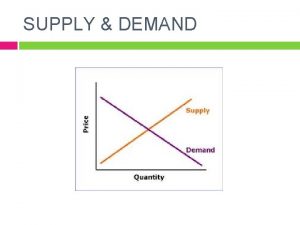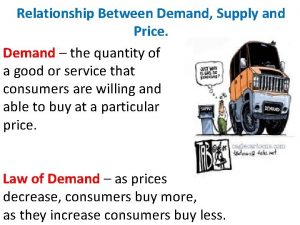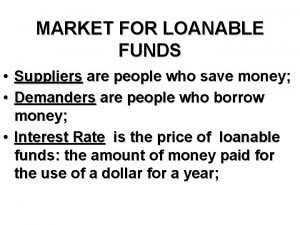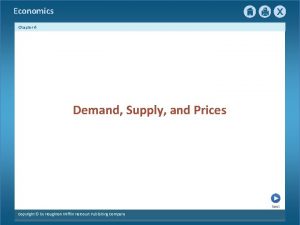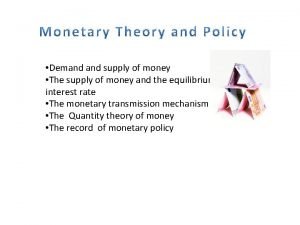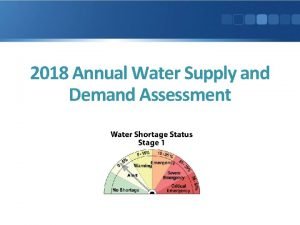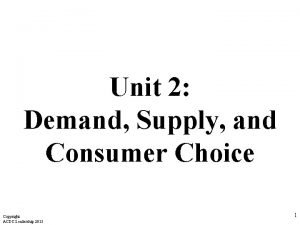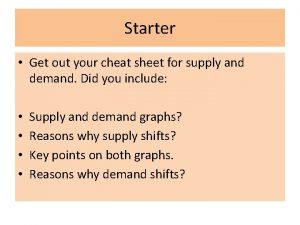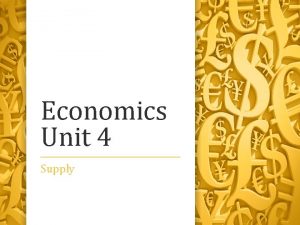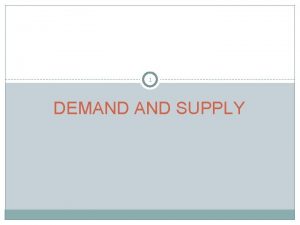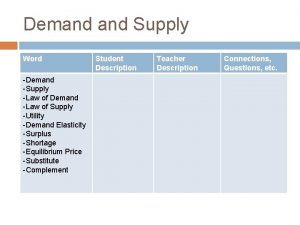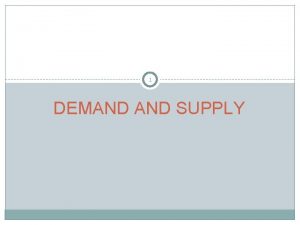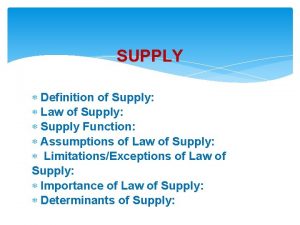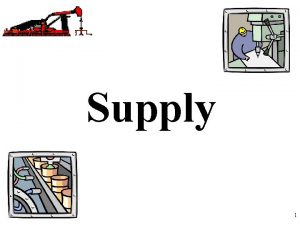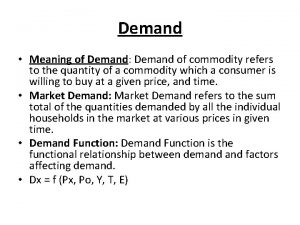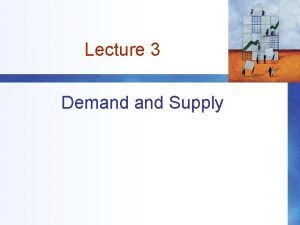DEMAND SUPPLY 2192013 1 Demand Analysis Demand refers



































- Slides: 35

DEMAND SUPPLY 2/19/2013 1

Demand Analysis • Demand refers to the quantity of a good (commodity or service) that consumers are willing to purchase (buy) at each price per unit of time in a given market, other things being equal (ceteris paribus). • Demand is a relationship between quantity purchased and price 2/19/2013 2

Demand Analysis Demand represented as • Demand Schedule (Tabular) • Demand Curve (Graph) • Demand Function (Equation) 2/19/2013 3

Law of Demand The quantity of a commodity demanded increases as its own price falls, other things being equal. Or The quantity of a commodity demanded falls as its own price increases, other things being equal. 2/19/2013 4

Law of Demand • There is a negative or inverse relationship between price and quantity demanded. • This inverse relationship is called the law of demand. 2/19/2013 5

DEMAND SCHEDULE: MAIZE DEMAND BY A HOUSEHOLD PRICE( GHC/bag) 2/19/2013 QUANTITY DEMANDED (bags/month) 90 4 80 6 70 9 60 14. 5 50 20 40 25 30 28 6

DEMAND CURVE FOR MAIZE Price ₵/bag D 100 80 60 40 20 D 0 2/19/2013 5 10 15 20 25 30 Quantity bags/month 7

MARKET DEMAND The market demand for a commodity is the sum of individual household demand at each price. Assuming there are just 3 buyers in a market, each demanding the following quantities at various possible prices. The market demand is the sum of the individual demands. 2/19/2013 8

MARKET DEMAND FOR MAIZE, THREE BUYERS PRICE PER BAG (CEDI) QUANTITY DEMANDED TOTAL 1 ST BUYER 2 ND BUYER 3 RD BUYER MARKET DEMAND/WEEK 22 10 12 8 30 20 20 23 17 60 17 35 39 26 100 15. 5 55 60 39 154 13 80 87 54 221 2/19/2013 9

2/19/2013 10

Demand Function Pi Own price maize Pi Qi substitutes rice Pr bread Pi Qi complements butter/margarine normal good Y Q inferior good Y Q Y 2/19/2013 11

Factors Affecting Demand 1. 2. 3. 4. Own price of the commodity Income of consumers Prices of related commodities Size of the population/number of consumers in the market 5. Taste or preferences of consumers 6. Consumer expectations about future prices and incomes NB- to examine the effect of each factor on the demand for a particular commodity, all the other factors affecting demand must be held or assumed constant. 2/19/2013 12

Factors Affecting Demand Distinction between: • Change in quantity demanded: a movement along the demand curve • Change in Demand: a shift in the demand curve. • Apart from a commodity’s own price all other factors affecting demand are known as shift factors (demand shifters). 2/19/2013 13

Price D P 0 a P 1 0 b D q 0 q 1 Quantity The movement from point ‘a’ to point ‘b’ when the price changes from P 0 to P 1 is a change in quantity demanded of the commodity(from q 0 to q 1). A reverse movement is also a change in quantity demanded. 2/19/2013 14

Change in Demand • Is a change in the demand schedule data; or graphically, a shift in the location of the demand curve. • A Change in the level of any of the demand shift factors (demand shifters) causes the demand curve to shift (either upwards to the right or downwards to the left). • Therefore, a change in demand is caused by changes in the level of any demand shifters but not by the own price of the commodity. • Illustrate effect of changes in income on demand 2/19/2013 15

An upward shift of a demand curve to the right represents an increase in demand while a downward shift to the left represents a decrease in demand. Fig. Changes in Demand Price D 1 D 0 D 2 P 0 D 1 D 2 0 2/19/2013 q 2 q 0 q 1 D 0 quantity 16

Change in Demand In the figure, the shift in the original demand curve D 0 D 0 to either D 1 D 1, or D 2 D 2 represents a change in demand. The upward shift of the demand curve from D 0 D 0 to D 1 D 1 is an increase in demand. The downward shift from D 0 D 0 to D 2 D 2 represents a decrease in demand. Note that the own price (P) does not change. 2/19/2013 17

Discussion of Factors affecting Demand Income • Commodities whose demand varies directly with income are called superior or normal goods. • Commodities whose demand varies inversely with a change in income are called inferior goods. e. g. Rising income may decrease demand for used clothing, third hand automobiles, certain foods (e. g gari). 2/19/2013 18

Discussion of Factors affecting Demand Prices of Related Goods • A substitute is a good which can be used in place of another good. Butter and margarine are examples of substitute goods. • When two products are substitutes the price of one good and the demand for the other good are directly related. • A complement is a good used in conjunction with another good. They are jointly used. • When two commodities are complements, the price of one good and the demand for the other are inversely related. 2/19/2013 19

Discussion of Factors affecting Demand Taste or preferences A change in taste or preferences in favor of a commodity increase the demand while unfavorable change in taste will decrease the demand. Number of buyers An increase (decrease) increased (decreases) dd. 2/19/2013 20

Summary: An increase in demand can be caused by; 1. A favorable change in consumer tastes. 2. An increase in the number of buyers. 3. Rising incomes if the product is a normal good. 4. Falling incomes if the product is an inferior good. 5. An increase in the price of a substitute good. 6. A decrease in the price of a complementary good. 7. Consumer expectations of higher future prices (and incomes). 2/19/2013 21

Supply Analysis • Supply Is the quantity of a particular commodity or service that producers are willing to offer or put on the market for sale at each price per unit of time, ceteris paribus. 2/19/2013 22

Law of Supply • Law of Supply: the quantity supplied of a commodity per unit of time increases with its price, ceteris paribus. • There is a positive or direct relationship between price and quantity supplied. • As price rises, the corresponding quantity supplied rises. • As price falls the quantity supplied also falls. 2/19/2013 23

Supply Schedule Is a list of possible prices and their respective quantities of a commodity offered for sale (supplied) 2/19/2013 24

A SUPPLY SCHEDULE FOR A COMMODITY 2/19/2013 PRICE ( CEDI/BAG) QUANTITY SUPPLIED (BAGS/MONTH) 90 27 80 25 70 19 60 14. 5 50 10 40 5. 5 30 3 25

A FARMER’S SUPPLY CURVE FOR MAIZE Price (₵ /bag) 100 S 80 60 40 S 20 5 2/19/2013 10 15 20 25 30 Quantity (bags/month 26

Supply Function Factors Affecting Supply - the commodity’s own price - Prices of other goods - Prices of factor inputs(resources) - Type of technology used (technique of production) - Number of producers - Future price expectation of producers - Natural factors (such as weather (rainfall), bushfires, pests and diseases outbreak. 2/19/2013 27

Change in Quantity Supplied and Change in Supply A Change in Quantity Supplied Is a movement along a given supply curve. Changes in the commodity’s own price leads to a change in quantity supplied of a commodity but not a change in supply. S Price b P 1 a P 0 S q 0 2/19/2013 q 1 Quantity 28

A Change in Supply Is a shift of a supply curve It means the entire supply curve shifts An increase in supply shifts the curve downwards or outward to the right A decrease in supply shifts the curve upwards or inwards to the left Apart from the commodity’s own price, all the other factors of supply are known as shift factors (shifters). A change in the level of any of the shift factors will causes the supply curve to shift 2/19/2013 29

Price S 2 S 0 S 1 P 0 S 2 S 0 S 1 0 q 2 q 0 q 1 Quantity - The shift in the original supply curve from S 0 S 0 downwards to S 1 S 1 is an increase in supply from q 0 to q 1 at the same own price P 0. 2/19/2013 30

FACTORS EFFECT Increase in Supply can be caused by any of the following 1. Decrease in price of other commodities produced with the same/similar inputs. 2. Decrease in price of input (cost of production). 3. Used of improved or modern technology in farm production. 4. Increase(larger) in number of producers/suppliers. 5. Favourable weather conditions( ie. Good and adequate rainfall). 2/19/2013 31

- Decrease in supply can be caused by 1. Increase in price of other commodities produced with the same/similar inputs. 2. Increase in price of input (cost of production). 3. Use of primitive or traditional production methods. 4. Decrease/smaller number of producer/supplier. 5. Unfavourable factors (e. g. Flooding, drought, bushfires, pest and diseases outbreak). 2/19/2013 32

Market Equilibrium The market equilibrium occurs when at a certain price, quantity demanded is equal to quantity supplied Market clears. Equilibrium price: Also known as market clearing price, is the price at which the quantity demanded is equal to the quantity supplied. Equilibrium quantity: is the quantity exchanged at the equilibrium price. 2/19/2013 33

P D S EXCESS SUPPLY (SURPLUS) E PE EXCESS DEMAND (SHORTAGE) S D q. E 2/19/2013 Q 34

PRICE QUANTITY DEMANDED QUANTITY SUPPLIED STATE OF MARKET PRESSURE ON PRICE 90 4 27 23 - excess supply (surplus) DOWNWARD 80 6 25 19 - excess supply (surplus) DOWNWARD 70 9. 5 19 9. 5 - excess supply(surplus) DOWNWARD 60 14. 5 0– equilibrium NEUTRAL 50 20 10 10 - excess UPWARD demand(shortage) 40 25 5. 5 19. 5 - excess UPWARD demand(shortage) 30 28 3 25 - excess UPWARD demand(shortage) 2/19/2013 35
 Matching supply and demand in supply chain
Matching supply and demand in supply chain Module 5 supply and demand introduction and demand
Module 5 supply and demand introduction and demand Effective desire
Effective desire Ap macroeconomics supply and demand analysis
Ap macroeconomics supply and demand analysis Extensions of demand and supply analysis
Extensions of demand and supply analysis Demand and supply analysis in managerial economics
Demand and supply analysis in managerial economics Supply of good refers to
Supply of good refers to Chapter 5 section 1 supply
Chapter 5 section 1 supply Elastisidad ng supply
Elastisidad ng supply Demand of commodity refers to
Demand of commodity refers to Unit 2 demand supply and consumer choice
Unit 2 demand supply and consumer choice Shifters of supply
Shifters of supply Unit 2 demand supply and consumer choice
Unit 2 demand supply and consumer choice Money market equilibrium
Money market equilibrium Supply vs demand side economics
Supply vs demand side economics Combining supply and demand worksheet
Combining supply and demand worksheet Interaction of demand and supply
Interaction of demand and supply What is the relationship between supply and price
What is the relationship between supply and price Supply and demand of loanable funds
Supply and demand of loanable funds Shifters for loanable funds
Shifters for loanable funds Supply and demand economics project
Supply and demand economics project Chapter 6 section 2 supply and demand in everyday life
Chapter 6 section 2 supply and demand in everyday life Halimbawa ng demand
Halimbawa ng demand Money supply curve
Money supply curve Rule of supply and demand
Rule of supply and demand Aggregate of chapter 6
Aggregate of chapter 6 Aggregate supply shocks
Aggregate supply shocks Chapter 33 aggregate demand and aggregate supply
Chapter 33 aggregate demand and aggregate supply Aggregate supply and demand graph
Aggregate supply and demand graph Annual water supply and demand assessment
Annual water supply and demand assessment Ad curve graph
Ad curve graph Unit 2 demand supply and consumer choice
Unit 2 demand supply and consumer choice Supply and demand together
Supply and demand together Demand n supply
Demand n supply Supply and demand cheat sheet
Supply and demand cheat sheet Supply and demand conclusion
Supply and demand conclusion




